|
Camp 30
Canada’s historic jewel faces the wrecking ball!
By Eye Spy Canadian Editor, Lynn Philip Hodgson
Snow flies across the windswept fields of Camp 30, the buildings now empty. Derelict. In the distance I see the ghostly images of three men walking side-by-side, talking quietly, stately in the tailored uniforms of Hitler’s Third Reich. Given their insignia, I see they are Generals. One is General Johann von Ravenstein, second-in-command to Field Marshal Erwin Rommel, captured in the desert of North Africa along with a wealth of information in maps and orders from Adolf Hitler himself. The others are General Artur Schmitt, also captured in Africa while orchestrating this theatre of war, likewise under the command of the ‘Desert Fox’ and General Georg Friemel, who was captured during the Blitzkrieg.
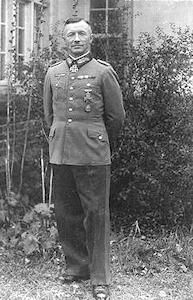 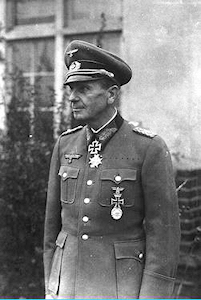
Generalleutnant Schmitt and Generalleutnant von Ravenstein at Camp 30
I see the three men are now joined by a fourth, smartly dressed in his Kriegsmarine uniform, and I quickly identify him as one of the most successful military men of the Third Reich: the Famous Korvettenkapitan, Otto Kretschmer. By the time Kretschmer’s U-99 (U-Boat) was captured in 1941, he had sunk more tonnage than any other U-Boat Commander, including all of those who were never captured. For this, he was awarded the ‘Knights Cross with Oak Leaves and Swords’ and, while a PoW, was promoted to Fregattenkapitän.
Of course, all of this was just my daydream. I only imagined myself walking in the shadows of such famous people.
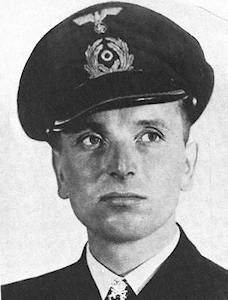
Korvettenkapitan, Otto Kretschmer
Early on in the war, it became evident to the British that they must establish a detention centre for German prisoners of war, especially the officers. The location needed to be secure, still within a Commonwealth country, but as far from Britain as possible. Camp 30 satisfied all these criteria. The British could not afford to take the captured German officers back to Britain: in the event that Germany were to be successful in invading Britain, the German officers would then be released immediately and put back into battle from within Britain. Therefore, the captured German officers were sent to Canada where, ironically, they ended up incarcerated only thirty minutes from the now famous spy camp, Camp-X.
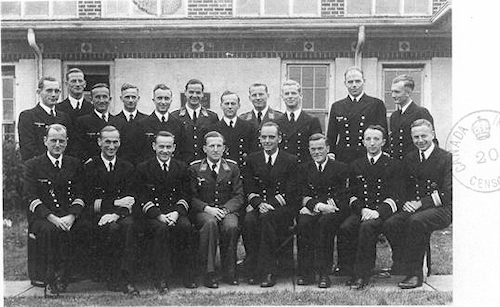
German officers of the Third Reich, Camp 30, Bowmanville - 1942
Throughout the War, Camp 30 housed approximately 880 high-ranking German officers. In 1942 the PoWs took over the Camp in what would be famously known as ‘The Battle of Bowmanville’, but after three hard-fought days, the Germans tired and relinquished their hold on the Camp.
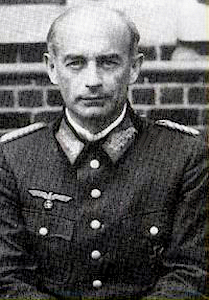
GeneralMajor Georg Friemel (courtesy islandfarm.fsnet)
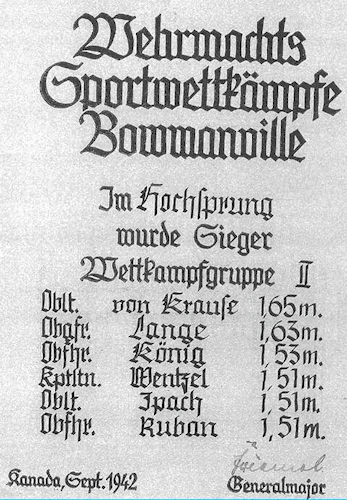
GeneralMajor Friemel’s signature can be seen on this poster of finishes at a competition
held at Camp 30 in September of 1942, just one month before the famous Battle of Bowmanville.
In early 1943, Admiral Doenitz, Commodore, (Führer der Unterseeboote) ordered the German Command at Camp 30 to arrange for the escape of Otto Kretschmer. Through an elaborately implemented plan, a ‘U-Boat’ would be waiting for Kretschmer off the coast New Brunswick at Maisonnette Point on September 27, 1943. The commanding officers had eight months to get him there. An escape plan was begun; a Navy tunnel would be constructed.
Through the summer of 1943, the men worked three shifts daily, tunneling fifteen feet beneath the building. A sophisticated method for removing the dirt was devised: bag after bag, the earth was placed on a trolley track, then it was lifted from one person to the next until it made its way to the attic of Haus IV. Someone then emptied the bag, sprinkling the earth gently over the rafters. The tunnel extended over three hundred feet, passed under Lambs Road and into a cornfield, a safe distance away from the guards’ tower. All went well: the tunnel was completed two weeks before the planned escape. Then all hell broke loose. From here, the story reads like a le Carré novel. But this was fact. Kretschmer never did make it out of Camp 30, until the war was declared over.
At the end of the war, Generalleutnant von Ravenstein was sent to Scotland to attend ‘de-nazification’ Camp 165 Watten, and was finally released in 1947. Von Ravenstein later wrote a book wherein he stated that had he not been captured and interned at Camp 30 during the war, he would have been murdered by Hitler’s henchmen as his name appeared on the list of 5,000 suspected co-conspirators of the failed attempt on Hitler’s life on July 20, 1944 at Rastenburg, ‘The Wolf’s Lair’.
That is all history. Today, this beautiful and historic facility is about to become another victim of ‘progress’ and ‘development’, just like Camp-X, #20 EFTS. Why do we, as Canadians, feel compelled to destroy our past and our identity? Perhaps it is our fear to offend.
If you would like to preserve this very important piece of our history, and to see Camp 30 saved from the wrecking ball, please contact immediately:
The Municipality of Clarington, 40 Temperance Street, Bowmanville, ON, Canada - L1C 3A6
Or e-mail: info@clarington.net
For further information regarding the history and significance of Camp 30, please go to our Camp-X book store
**********************
Here is another story from the famous Camp...
Conduct to the Prejudice of Good Order
By ‘Eye Spy’ Canadian Editor, Lynn Philip Hodgson
Yes, this is what had been typed on Oberleutnant Peter Krug’s ‘Conduct Sheet’ May 8th, 1942.
Conduct to the prejudice of good order and Military Discipline amongst Prisoners of War in that he did escape from Camp 30 on April 17, 1942.
Had Peter Krug attempted this escape from the German PoW Camp 30 at Bowmanville, Canada, a mere five months earlier, he likely would have made it back to Germany safely. But after December 6th, 1941, that Day of Infamy, the successful escape and return to Germany of any PoW held in Canada, became an almost impossibility.
Peter Krug ended up at Camp 30 Bowmanville as many others did before him, shot down while flying a Dornier Bomber over England. Wounded, Krug spent time convalescing in a British hospital before being sent overseas to Canada and Camp 30.
While at Camp 30, a one hundred and ten acre site consisting of several buildings used for housing, lush green grounds and a multitude of sporting facilities, Krug, along with his friend Erich Boehle, hatched a brilliant idea for escaping. They had conceived the idea of posing as Canadian workmen going about their daily routine of repairing various things in need of maintenance.
On April the 17th 1942, the two men, with the help of the entire camp, started to walk toward the double barbed wire fences. The men were of course being guarded by one of their own men wearing a Canadian army uniform, which was provided by the theatrical group, who also donated supplies they would need. The German Abwehr, through their agents in Canada, had smuggled in forged documents, Canadian and American currency and maps. Also, a soccer game had been arranged in order to cause a distraction at the very moment that the men would make their escape.
Pretending to be repairing the barbed wire fence, and marking the spots with paint, the two men climbed the fence using a ladder and went over the top. But now there was another fence about fifteen feet away. Nervous and afraid that the caper would be up, the men walked toward the outer fence and again put the ladder into position. After successfully climbing over the second fence they sat down for a rest and a few minutes later, stood up and preceded to just walk away.
The men made it successfully to Union Station in Toronto where they decided it would be best if they were to slit up; they said goodbye and went on their separate ways. Leutnant Erich Boehle was captured on Lewiston Road only a mile from potential freedom. Peter Krug however had a much more exciting and longer flight of freedom.
The Camp 30 commandant, Colonel Bull, received a phone call from the Niagara Falls Police Department asking him if he were missing any prisoners. Colonel Bull ensured the constable that indeed he was not. The constable insisted and asked him to check again specifically for one Erich Boehle. Yes, they did have a PoW named Erich Boehle but at roll call he was not missing, how could this be? Another elaborate and brilliant idea of the theatrical group made it possible and likely would not have been detected for some time if it had not been for Boehle being picked up so quickly.
The theatrical group had made dummies using papier-mâché, a uniform, and plenty of paper stuffing. The dummies had been hauled out for each roll call and strategically placed in the middle of the bunch while being held upright by PoWs on either side.
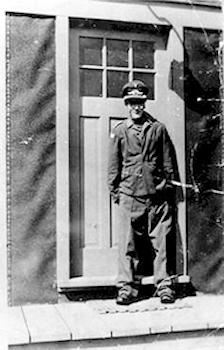
Camp 30 dummy – photo credit – Bowmanville Museum
After a double count of PoWs, still no one was missing. Colonel Bull ordered a oral count where all PoWs would have to call out when their names were called and it was only then that it was found that not only was Leutnant Boehle missing but Oberleutnant Krug as well.
While Boehle was being returned to Camp 30 to serve his 28 days in solitary confinement as his punishment, Oberleutnant Krug was still at large and was now a wanted man as part of a massive search on behalf of law enforcement. Krug’s cover story was so convincing that he managed to convince a Priest to buy him a bus ticket to Windsor Ontario where there was a job awaiting him.
Arriving at Windsor on the evening of April 17th, Krug lay low until the next day when he would attempt to get across the St. Clair River to Detroit. The morning of the 18th, Krug walked along the shoreline of the river searching for some means of getting across. Finally, he found a rowboat and after manufacturing some make shift oars; he succeeded in rowing across the river. Peter Krug celebrated his 22nd birthday in the United States.
The Abwehr’s agents had provided Krug with names and addresses of safe houses, which he was to contact if he were to make it safely to Detroit. His first contact was a Mrs. Bertelmann who in turn introduced him to restaurant owner Max Stephan. Given food and lodging and money for his trip, Krug headed out for his final destination, Mexico, a neutral country.
Krug’s luck changed from good to bad when he arrived in San Antonio Texas. Here he checked into a hotel where keen eyed manager had recognized Krug from an FBI photo, which had been distributed the previous day. The manager contacted the FBI who quickly arrested the surprised Oberleutnant Krug. After two hours of interrogation, Krug finally admitted to who he was and when questioned further as to how he had planned to cross the border into Mexico, Krug replied that he intended to, “swim across the Rio Grand.”
From items found in Krug’s bag by the FBI, among other things a military map of his escape route, FBI agents were able to trace back to Mrs. Bertelmann, Mr. Stephan and a man named Theodore Donway. Also found in his hotel room was a .32 calibre handgun which he had purchased for $13 from a Pawn Shop.
Krug, arrogant in many ways, caused a stir when he appeared in court dressed in his Luftwaffe uniform and when questioned, belittled Americans as being, “Stupid” for believing him when on no fewer than seven occasions he passed forged documents to different levels of authority without as much as any suspicion. Back in Detroit, Max Stephan was arrested and charged with ‘harbouring an alien’. At his trial, he was convicted of his crimes and was sentenced to death, which was later commuted to life in prison. Mrs. Bertelmann was interned as an ‘Enemy Alien’ for the duration of the war. Theodore Donway received a fine and imprisonment for his involvement.
Peter Krug was eventually returned to Camp 30 where the commandant immediately began processing paperwork to have him transferred to the more secure camp at Gravenhurst where his ‘Conduct Sheet’ would have the following new notations.
29 Nov. 1942 “Conduct to the prejudice of good order and discipline among Prisoners of War” in that he at Gravenhurst on 29 Nov. 1942 attempted to escape by cutting a hole through the dining room floor of the P./W. Mess Hall.
And the final notation of:
2 Aug. 1943 “Conduct to the prejudice of good order and discipline among Prisoners of War” in that he at Gravenhurst Ont. on 2 Aug. 1943, at about 1500 hours did escape from a swimming party and was absent until apprehended at North Bay, Ontario, at about 0200 hours on 5 Aug. 1943.
Research sources: Camp 30 Word of Honour - Hodgson/Longfield, The Bowmanville Museum, The Toronto Star, The Detroit Free Press, San Antonio Express, ‘Ehrenwort’ Daniel Hoffman, Bruno Petrenko, Volkmar König, Life Books
**********************
March 28th, 2009, a sad day in Canadian history; this is all that is left of the Camp 30 ‘General’s Haus’ after some despicable person was through with it.
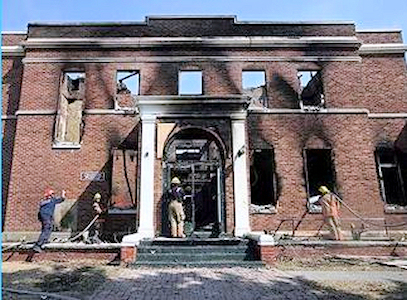
Photo credit - YVONNE BERG - THE TORONTO STAR
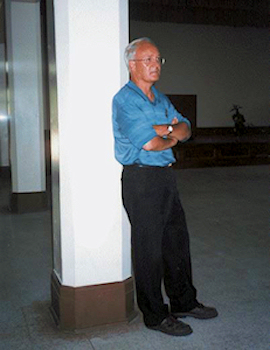
Lynn inside the Admin building in 2002.
“It’s as if I could see the future.”
|

 (289) 828-5529
(289) 828-5529